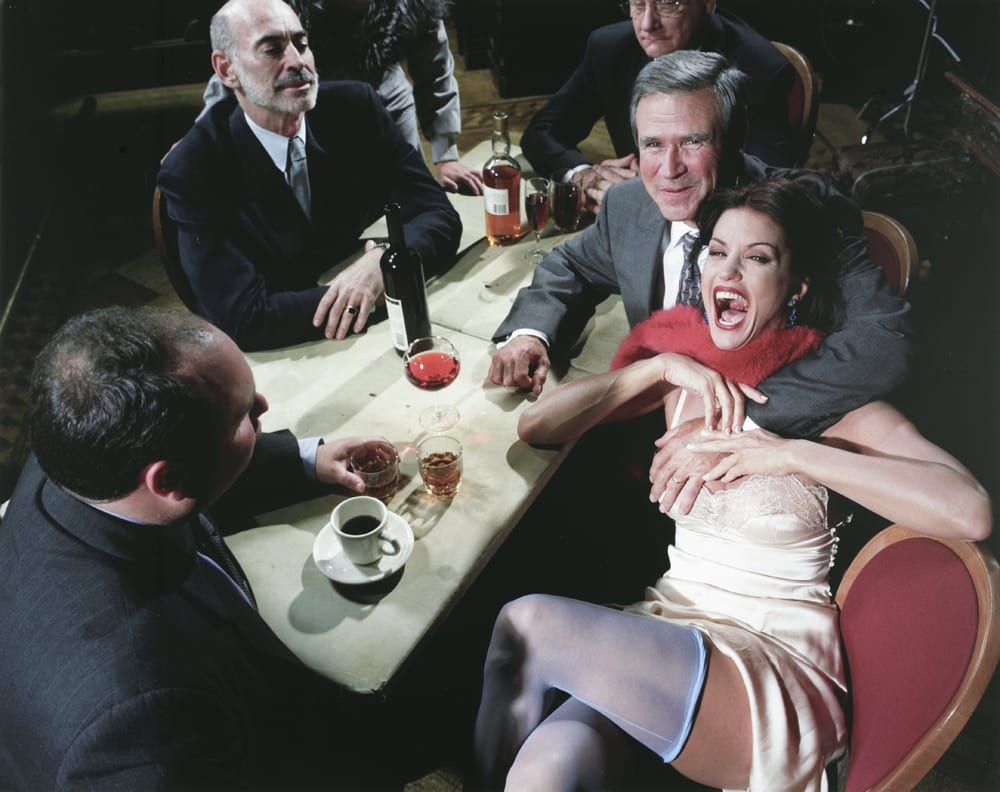We would like to believe that we live in a world where artists are free to create without fear of retaliation from government or special interest groups but time and time again there are occurrences around the world that remind us that censorship is alive and well. The most recent instance of censorship that is garnering media attention is the Russian police raid on the Saint Petersburg Museum of Power.
 The police seized four paintings by Konstantin Altunin from his Rulers series, which includes a painting of President Vladmir Putin and Prime Minister Dmitry Medvedev posed together wearing women’s lingerie; another painting depicts anti-gay lawmaker Vitaly Milinov against a rainbow backdrop. After the raid Altunin wisely fled the country to seek asylum in France, while the police have detained museum curator, Tatiana Titova, two times since the raid.
The police seized four paintings by Konstantin Altunin from his Rulers series, which includes a painting of President Vladmir Putin and Prime Minister Dmitry Medvedev posed together wearing women’s lingerie; another painting depicts anti-gay lawmaker Vitaly Milinov against a rainbow backdrop. After the raid Altunin wisely fled the country to seek asylum in France, while the police have detained museum curator, Tatiana Titova, two times since the raid.
Many of us would also like to believe that Americans are free to view art work that is critical of government officials and practices, but it is not the case! Although our policy makers use more subtle tactics compared to police raids, our artists, galleries and museums battle censorship issues as well. In 2010 Jeffrey Deitch decided to paint over Italian graffiti artist Blu’s large scale mural at the LA MOCA because it showed coffins of war casualties draped with American dollar bills. Andres Serrano’s work Piss Christ (1987) caused outcry against the artist and launched an attack on the NEA for funding his work. The Corcoran Gallery of Art backed out of showing Robert Mapplethorpe’s work in 1989 because they realized the controversy that the art work would stir up. Like Serrano, Mapplethorpe was working under an NEA grant and Corcoran wanted to spare the NEA from being punished with further budget cuts. As a result the gallery landed in the midst of a media whirlwind where it was depicted as the censor! The history and the difficulties experienced by the NEA could be an entire blog of its own (I will have to get working on that one!). But as I mentioned before, the tactics in America are not as blatant as police raids. Our government and special interest groups know how to apply pressure and to make one fearful of potential consequences.
I will close with the story of American photographer Larry Fink’s series of work, The Forbidden Pictures, which were exhibited at LUAG in 2004. Fink is a master photographer who exhibits regularly in New York, Los Angeles and Paris and has had one man shows at major museums around the world. He is famous for his works in black and white but he ventured into working in color for the first time with The Forbidden Pictures. NY Times had agreed to publish the collection of photographs that referenced the cultural period of Weimar Germany and dealt with satire. The photographs were due to run on September 16th, 2001 but in the wake of 9/11, the Times pulled the photos because of the work’s satirical and critical nature towards the Bush administration. Once Americans started to turn a critical eye on the administration’s political practices, Fink approached the Times with the photos again. They refused! So he moved on and offered the photos to The New Yorker, Harper’s Magazine and publications from the European market. All declined! Fink’s observed that, “Like their influences, the images were banned, not by decree but by mute fearful compliance to the norm.” The Forbidden Pictures were finally exhibited in Spring 2004 in LUAG’s DuBois Gallery and stirred up an unexpected outburst of protest. However, LUAG Director/Curator Professor Ricardo Viera feels that art should generate emotion! Whether it is a good or bad reaction, it should always be a strong response, never indifferent. The reaction to Fink’s exhibit was definitive; a movement was sparked to have the photographs taken down. Professor Viera decided to keep the exhibit on display.
Do you feel that there is a time where political leaders and institutions should be protected from criticism? What do you think the consequences would have been for a newspaper or magazine that ran The Forbidden Pictures?
Whatever your opinion on the matter, you are entitled to your own thoughts. All of these stories give us all the more the reason to visit the Lower Gallery to see Fink’s photograph Homage to George Grosz (2001) so that we can FREELY engage in the enjoyable debate of ‘Is It Art?’ or please chime in with a comment below.

I remember that decision to keep the Fink exhibit up by Prof. Viera and was very glad to see it at the time. One of the first few early demonstrations of commitment to a real public debate on artistic dialogue and criticism that was not self-censored by fear that I was personally aware of. It even seemed to take two more whole years until Stephen Colbert’s famous press corps dinner speech/lampoon in 2006 for this “mute compliance to the norm” to begin to abate.
Thank you for such a thoughtful post. The exhibit downstairs stirs up a good amount of debate, not only on what is art but what we personally find acceptable for artists to express and what issues they address.
We hope you keep reading!
Interesting… New York Post cartoonish Sean Delonas was lambasted by liberals for a piece that showed a dead chimp with the shooter/authorities saying “they’ll have to find someone else to write the stimulus bill”… but this… because it’s “art” is OK.